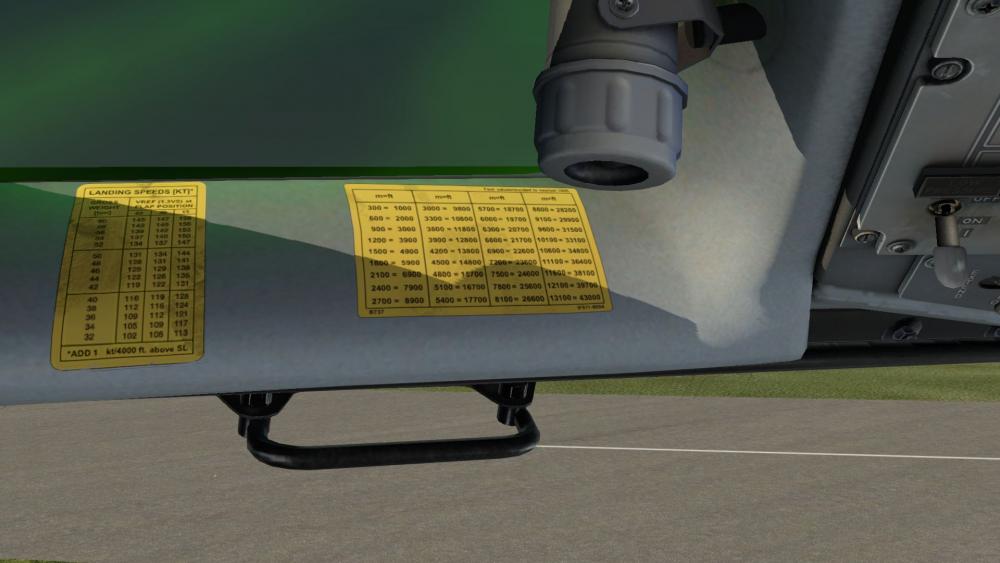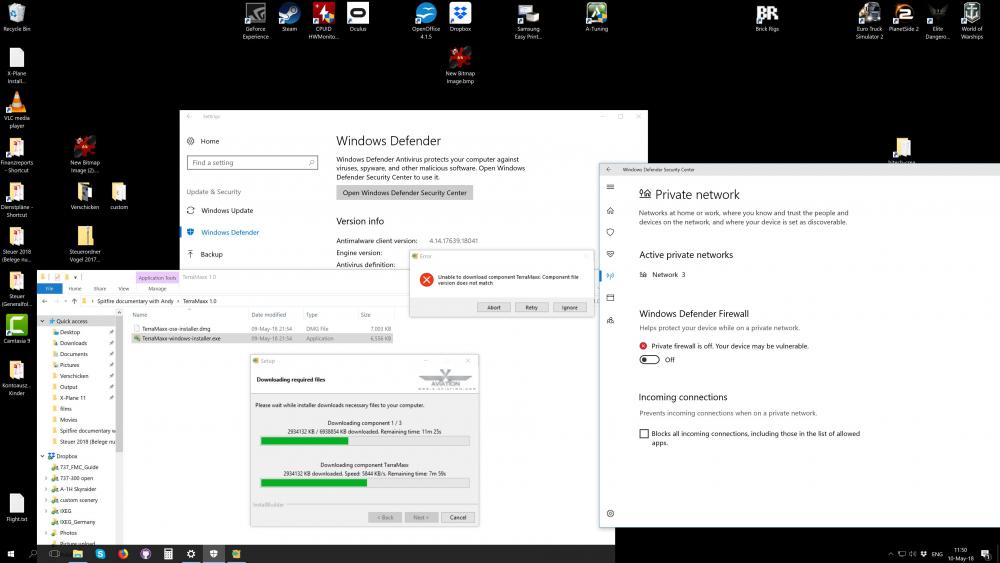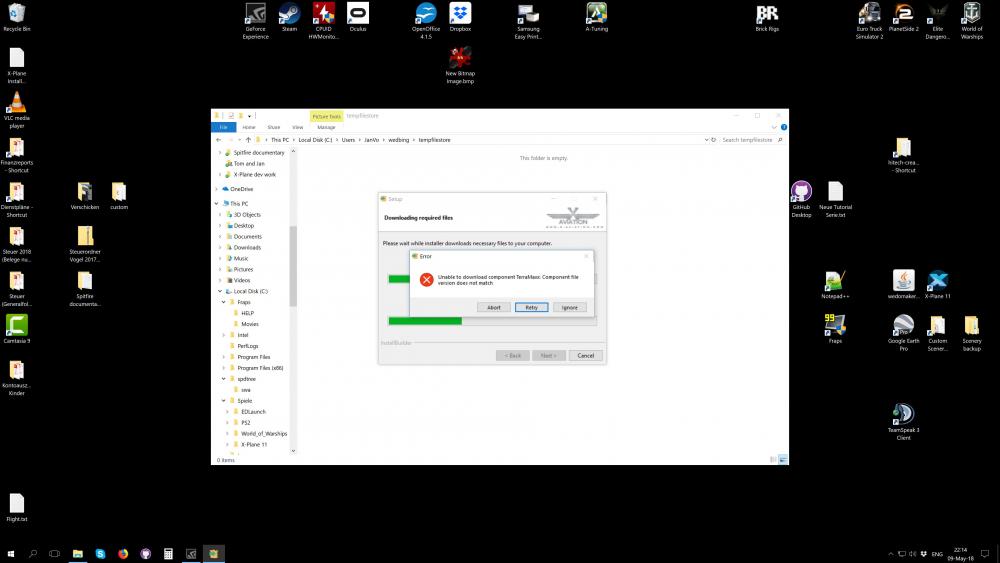-
Posts
5,694 -
Joined
-
Last visited
-
Days Won
417
Content Type
Profiles
Forums
Latest X-Plane & Community News
Events
Downloads
Store
Everything posted by Litjan
-

Throttle not responding to user input
Litjan replied to JoshBlack3's topic in 737-300 Aircraft Systems and Operation
We haven´t heard that one before, but it may be possible that you are assigning the throttle to some wrong throttle command. Try browsing the list, there may be another, more generic throttle command. I can´t see what you selected, due to the poor quality of the video, can you tell me which command you assigned to your left and right hardware throttle? If some other axis is assigned to throttle, it is likely that you can´t move them with mouse or keys at all. Cheers, Jan -
Hi Baron, thanks for the kind words! To answer your questions: 1.) When we built the plane, there was no scroll wheel manipulation in X-Plane yet, that is why we didn´t implement it. It is on the list of things we plan to add. 2.) I don´t think the book will be offered on the XA store, but you can buy it from Mike Ray directly. We worked with him on making that book and it is indeed a good companion! 3.) I don´t own the Go Flight Panel, but others have used them as well, so if you have any questions, make sure to post them in the hardware forum and I am sure others may help you there! 4.) The ACTUAL CG of the aircraft is only shown on the "load and trim" tab that pops out of the left-hand screen. It also shows the correct stab trim setting for take-off. You can enter that one into the correct field on the FMC for the take-off values, and the (same) stab trim settings will show. The cruise CG is actually only a performance planning value for the FMC, it is not taken into account yet, and also real pilots will only enter it if the cruise CG is at an extreme (otherwise it´s influence on actual fuel burn is very small). Cheers, Jan
- 1 reply
-
- 1
-

-

x-plane bug Anyone still regularly experiencing E46 Texas teleportation bug ?
Litjan replied to philipp's topic in Bug Reports
I think (knowing Tom) that he is aware that -290 is below 0K. However, an application should not crash or show other weird behaviour, even if a user is putting in data (even using DRE, which IS a tool supported by Laminar) that makes no sense. Furthermore, I think that Tom´s discovery could help solve the "teleport to E46 bug" - so pointing out that -290 is not physically possible is beside the point. Its like making an addon plane that crashes to desktop if people bank it more than 30 degrees, and then saying "well, airliners shouldn´t bank more than 30 degrees, so don´t do it!" Jan -
I can´t open your Log.txt for some reason - but if your X-Plane crashes it is usually a combination of plugins that is causing it. The normal troubleshooting sequence is to remove all plugins except for the ones needed to run the IXEG, then add them in one by one to see which one is causing the problem. Regular problems are flywithlua, xenviro, and any other plugins that alter art datarefs or such. You can also try to fly with the "show vortices" option disabled, that helped some people with crashes. Cheers, Jan
-
We definitely will - its pretty far up on the list of visual improvements planned! Cheers, Jan
-

solved Flashing engine emblems and eyebrow windows on outside view
Litjan replied to t4murphy's topic in Bug Reports
Yeah, the wingtip vortices where a "borderline" feature that worked ok in XP10 but caused some headaches for some people. We considered removing the effect altogether, and might do so for a future update. Happy you got it to work ok for you, cheers, Jan -

solved Flashing engine emblems and eyebrow windows on outside view
Litjan replied to t4murphy's topic in Bug Reports
Hi t4murphy, this is usually due to some other 3rd party program altering "art controls", like to get certain environmental effects, changed hue, colouring, etc. It could also be due to outdated graphics drivers. To troubleshoot, please disable all other plugins, then add them back one by one to find the conflicting one. Thanks, Jan -
Hehe - at my real job I deal with roughly 800-1000 customers every day, and let me assure you, sometimes the customer is a total idiot . Now to elaborate a bit more in relation to this post: I don´t think that Shobhan Nandy falls into that category. But I think he is victim of false expectations. I think he is really really REALLY fascinated with the details of the FMC and I must say that we did not develop this aircraft to be a training tool for FMC technicians. What does the term "study level" entail? Well, there are different perceptions, but I don´t think that any software exists (and that includes all LEVEL-D simulators) that can truthfully simulate the real aircraft´s behaviour in all circumstances. I am fully aware of our FMC´s shortcoming (although I never even knew the " version, revision and update version no. " of the FMC when I flew the real aircraft). We have placed emphasis on recreating the experience of flying a 737-300 in a realistic, "close to true life", fashion. I don´t even know some of the features that Shobhan is talking about (capture mode? Agility tuning?). We get good feedback on the areas that matter to me as a pilot (flight model, system modeling) and we are planning to work on the FMC some more in the future. I am not happy with the speed of updates myself, but it is what it is, to quote someone I know . Study level? Certainly not for the FMC, I agree. I can´t say if the Zibo mod is better than our aircraft, haven´t tried it myself. Cheers, Jan
-
Well, here is all I want to say about the OP´s post: You are entitled to your opinion. Cheers, Jan
-

x-plane bug Anyone still regularly experiencing E46 Texas teleportation bug ?
Litjan replied to philipp's topic in Bug Reports
Hello Phillipp, here is the link to the original thread with the problem. fabiosko seemed to be able to trigger this one fairly reliably, but I am not sure how much he still experiences this. I will also PM you with some info on this. Thanks for helping us out, Jan -

Sound issue in circle view mode of 737-300 Classic
Litjan replied to shabani's topic in Hardware/Cockpit Dev
Hi shabani, I don´t think the problem lies with x-aviation or that they can do anything about your sound problem. We have our own IXEG custom sound engine providing the 3D-sound for our add-on and there is a chance that a combination of sound chip/hardware properties and/or other add-ons could cause your problem. At this point it is unlikely that we can fix or help you with your problem, especially since you are the only one who has reported it. I am sorry that you have a degradation in sound quality, but we can not recreate the problem and therefore not fix it. Cheers, Jan -
Thanks, Ben - I dare not to tinker too much with my router settings. I remember an unfortunate attempt a few years ago to open some specific ports and that went really not well at all. I prefer the "get the long LAN cable out of the basement and run a bypass" solution . Cheers, Jan
-
Update: Finally got it to work, and I am posting how here to help other people with the same problem and X-Aviation in troubleshooting the problem. This is how my computer is connected to the internet: 1.) The signal (DSL) enters the house and goes into a WLAN router. 2.) The line goes from the WLAN router into a second WLAN router (in my office), type Netgear WGT624. 3.) The line goes from the second router into my computer. This configuration did not work with the download. However, when I plugged my computer directly into the first router (bypassing the Netgear), things worked flawlessly. Off to some winter flying! Jan
-

Chinese airspace and metres
Litjan replied to AndersenBali's topic in 737-300 Aircraft Systems and Operation
By using a conversion table - and now look at that: It is mounted right in the cockpit for your convenience. Gee whiz! Jan -
-
Hi Cameron, yes, I run the regular firewall that comes with Win10... I always get the message at the same "spot" in the download, when about 1/3rd through the first (of three) packages. Never had a problem with downloading from X-Aviation before, so this is somewhat puzzling... Cheers, Jan
-
Hi everyone, during the download I got this error several times - only "ignore" allowed me to get past it (see attached screenshot). Then, during an attempt to load seasons into X-Plane, I get an onscreen warning and this in my log.txt: 0:00:00.000 D/HID: HID Bridge Running 0:00:00.422 E/SYS: +------------------------------------------------------------------------------- 0:00:00.422 E/SYS: | There was a problem loading the scenery package: 0:00:00.422 E/SYS: | Custom Scenery/SeasonsXP/ 0:00:00.422 E/SYS: | The scenery may not look correct. 0:00:00.422 E/SYS: | Please see the Log.txt file for detailed error information. 0:00:00.422 E/SYS: | (io_locate.cpp:394) 0:00:00.422 E/SYS: +------------------------------------------------------------------------------- 0:00:00.422 E/SCN: Custom Scenery/SeasonsXP/library.txt: 0:00:00.422 E/SCN: Incorrect version for scenery library file. Will skip. Running XP11.20. Any ideas? Thanks, Jan
-

IXEG 737 and Precision Flight Controls C2 Pro
Litjan replied to centerforcekid's topic in Hardware/Cockpit Dev
Hi Patrick, we use a whole bunch of custom code to control systems, so not everything that works for the default planes will work for ours...however: I don´t have the PFC but you may want to check any buttons for moving "mixture" to lean or cutoff, I think. The engine controls are pretty much default X-Plane, and when they run, the only thing stopping them is either the "mixture" setting (emulated by the idle/cutoff switches) ... or you may be toggling the fire switch inadvertantly (check on the center pedestal if one is "up" a little bit)... For the spoiler, reversing the direction may work - or it may be assigned to a lever so it won´t react to button input, no idea how you try to control it. Good luck, Jan -

x-plane bug [Merged]Steering and differential braking
Litjan replied to jimflys57's topic in Bug Reports
Thanks for letting us know it worked for you! Cheers, Jan -

x-plane bug [Merged]Steering and differential braking
Litjan replied to jimflys57's topic in Bug Reports
Hi everyone, I discussed the behaviour with Laminar Research, and they found this out: ************************************************************************ I got to the bottom of this. There is a nosewheel spring constant entered in Plane-Maker for the IXEG that is NOT in the LR 737. More details: 1. X-Plane 10 allowed a spring constant on a nose wheel or tail wheel, e.g. think bungee steering on a C172. 2. X-Plane 11 supports this ONLY for tail wheels - the code for bungees is a little hacky and doesn't work with the newer wheel physics in v11. Having proper nose wheel bungees is on Austin's future todo list, but for now X-Plane only uses this for the tail wheel (true for ALL of v11) for 11.30 Austin has a wording change coming until we fix all of this. 3. X-Plane wheel steer with differential brakes automagically if the plane has bungees OR castoring. So: set the spring force to 0 (correct value for an airliner, right??) and the brakes will stop braking. In the future we (LR) may start ignoring this variable if there is no tail wheel. ******************************************************* So please try to change this (if you are affected) in planemaker: Opem the 733.acf in planemaker, then open STANDARD/LANDING GEAR and click the GEAR DATA tab. In th top right corner you can see the "nosewheel spring force" - it is currently set to 30. Try to set it to 0 and let me know if this fixes the problem! If this fixes the problem, we will change this for the next update! Cheers, Jan -
Good to hear you got it solved! Jan
-
I looked at your log.txt and you are running more (possibly conflicting) plugins than I could count in an afternoon . I would ask you to remove them (temporarily) to find out which one is the culprit. My money would be on flywithlua or FSUIPC, possibly also the python interface. There is a boatload of warnings about "unassigend joystick axis" in your log as well, so I am not surprised that something isn´t working right... Cheers, Jan
-

Custom waypoints in IXEG 737
Litjan replied to vnangli's topic in 737-300 Aircraft Systems and Operation
Its not modeled in the IXEG 737, but certainly works in the real aircraft. We are planning to add it later - a (poor) workaround is making the point visible with the FIX page (enter a bearing and a radius, use HDG SEL to fly to the intersection of those). Cheers, Jan -

x-plane bug [Merged]Steering and differential braking
Litjan replied to jimflys57's topic in Bug Reports
Hi Ian, this sounds exactly like the problem Stephan describes. I have filed a report with Laminar - I can not figure out what our plane is doing differently from the default 737 (where just one axis for yaw works fine...) Cheers, Jan






